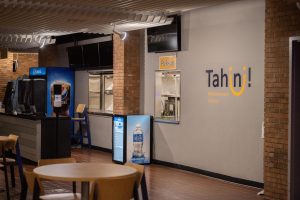Annual National Alcohol Screening Day set for Thursday
April 5, 2016
Emily, a sophomore education major who asked not to be fully identified, thought she was living a typical college lifestyle going to class by day and partying with her friends by night. It wasn’t until one of her friends was hospitalized for alcohol poisoning after a routine weekend house party that she got a wake-up call.
“At the time I didn’t even understand how much alcohol I was consuming on a routine basis,” Emily said. “When I was with my friends at a party or downtown at the bars, everyone was drinking and having a good time. I didn’t think anything of it, this is what college kids do. When my friend had to have her stomach pumped, I was shocked and knew that could have just as easily been me.”
Emily decided she needed to make a change, the situation with her friend was 100 percent preventable and she owed it to her to get them both help.
“I was afraid to talk to my parents, so I decided to go to Health Services,” Emily said. “They were so nice and understanding. I had no idea how many resources and programs they have in place for students and I am so grateful I went. They were really the beginning of my alcohol education and awareness as an adult. Now, I go to the National Alcohol Screening Day (NASD) every year.”
On Thursday, the University Health Office of Health Promotions will host NASD in the Student Center. The event will be held from 10 a.m. to 4 p.m. in the second floor lobby and is open to students, faculty, staff and community members.
Scott Dotterer, coordinator Student Health Promotions in the University Health Services, said NASD is an opportunity to talk about risk reduction. Dotterer encourages all students to participate in the screening, even if they don’t have a drinking problem.
“This event is all about risk reduction,” Dotterer said. “Every student will turn 21 here and will be faced with the choice to either drink or to not drink. We want those students to feel prepared and armed with the right knowledge to make an educated decision. There is a lot that goes into behavior change, and it’s important to have the support and resources in place before a risky situation occurs. We hope (that) with this event, students will act on the knowledge they learn here.”
Dotterer said the screening is not meant to be a diagnostic tool. The form will be used to identify habits and behaviors and begin making recommendations. Dotterer believes NASD is an opportunity for educating all students about the risks of alcohol, regardless of whether they drink or not.
“It’s about being proactive,” Dotterer said. “About three-fourth of students aren’t really at risk of binge drinking, but you don’t have to have a substance abuse problem to put yourself at risk. There are a lot of students who drink seldom but get caught in one situation that is high risk. When people are drunk they tend to make extremely poor decisions, and we want to reduce that risk as much as possible.”
Maureen Keating, a chemical dependency counselor in the University Health Services, encourages students to attend NASD as an educational opportunity. Keating said the screening helps students gain insight into their personal risks for getting a substance use disorder, as well as receive the appropriate recommendations.
Since Emily’s dangerous situation with her friend, she makes an effort to be as knowledgeable as possible when it comes to alcohol and substance abuse, and encourages others to not feel peer pressured by the college environment.
“Students often have a belief that everyone uses substances and to be part of the group they need to use,” Keating said. “There is an assumption of some students that college is the time to party and test limits. They perceive substances as a right of passage and note that it’s part of the ‘college experience.’ Some students submit to peer pressure and admit that others encourage them to use substances.”
This is a perception that Dotterer, Keating and Emily are working to dispel, in part through NASD. Keating said many students do not have reliable information about substance abuse and are also unaware of the long-term consequences abuse can have on their health, behavior and legal issues. NASD helps to address these risk factors and provide resources to students.
Emily is just one of the 209 students who participated in last year’s screening event. Dotterer said NASD has averaged 250 students over the past nine years, and he is hopeful this year will be no different.
NASD is completely anonymous and takes about 20 minutes. Participants will fill out the audit form, which will then be scored by a mental health professional. From there, students can sit down privately with a health professional to talk about their results and ask any questions.
Students can enjoy food and refreshments at the event and will leave with a resource bag that contains material on educational information ranging from blood alcohol level to alcohol content in common drinks.
NASD is a collaborative effort sponsored by student organizations such as the Body Acceptance Movement and Public Health Student Alliance, as well as Psychological Services and Counseling and Human Development Services.
Gabrielle Gentile is a student health reporter for The Kent Stater. Contact her at [email protected].












